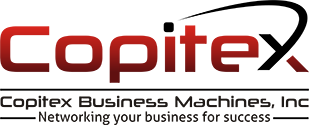Reprinted from Business News Daily
Office productivity and efficiency has increased over the years as technology has advanced. Instead of needing to have both a printer and a copier to get work done, you just find yourself a solid combination of both, with the addition of other features.
Multifunction printers (MFPs) combine printers and color copiers to simplify the workplace. Along with printing and copying, these machines can fax and scan to locations such as email, USBs and cloud-based services. The more advanced models can be customized with finishing options like stapling, hole-punching and sorting. These MFPs are designed to meet business printing needs while cutting supply costs and increasing workflow. They can be purchased or leased, and an array of accessories is available for most models.
Finding the right copier for your business can be overwhelming. To ease some of the stress, we’ve created this guide to break down the information you should know before choosing an MFP. We’ve outlined a variety of MFPs and the key features to look for.
Types of copiers
The first thing you’ll want to consider is whether you would like your machine to print in monochrome only or be able to print in color. Another thing to think about is the size of your office space – you’ll want to find a copier that fits nicely without taking up too much workspace. Once you’ve made a decision, you can start to consider the configuration you want. This will depend on your preferences and budget.
Monochrome and color MFPs
There is a difference in the costs of a monochrome printer and a color printer. Monochrome printers typically cost less due to the cartridges used. They only use one black cartridge, whereas the color printers require four separate cartridges: black, cyan, yellow and magenta. Supply costs will be lower if you only have to purchase one cartridge at a time rather than four. Also consider the impact on your branding and customers, though – colored images tend to grab attention faster than monochrome images.
Home vs. SMB offices
Copiers designed for home offices are typically desktop size to conserve space. Designs like these go for as low as $50, but we recommend spending $300 to $700 to ensure you get the best model for your business. Lower-priced desktop copiers are intended for casual individual use and will not meet the needs of most small business owners.
Office copiers are often freestanding or designed to take up a large tabletop and are built to suit the needs of a multi-person office. Copiers like these can typically be networked and include a variety of printing, scanning and faxing capabilities. You can even use different paper types and sizes with the more advanced models. Office printers start at around $1,200, but high-end models can run you $5,000 or more.
Production
If your business requires high-volume printing, professional-grade graphics and advanced finishing options, you may need a production printer. Production printers offer high resolutions, ranging from 2400 x 1200 dots per inch (dpi) for color copies to 9600 x 600 dpi interpolated with 8-bit color depth for black-and-white prints. Production printers vary greatly in cost depending on specific features, but they typically start around $7,000 for entry-level models and go well above $25,000 for specialty models.
Features to consider
Before making a decision, it’s a good idea to compare models by looking at their key features. This will help you determine which features you need and discover the accessories and software that are available.
Print speed
Print speed is one of the most crucial specs to look at when you choose a copier. Print speed is often listed on spec sheets as “ppm” for pages per minute. You’ll want to find a printer with enough speed to keep your workflow running smoothly. If you don’t print in high volumes, a lower speed will be fine for your business. We recommend a minimum of 25 to 30 ppm for microbusinesses and a minimum of 45 to 50 ppm for SMBs with average printing needs.
Paper capacity
You’ll find the paper capacity (often listed as “tray” or “cassette”) of a printer on its spec sheet as well as the sizes of paper it can print on. We recommend finding an A3 or A4 copier for an SMB. A3 machines can use paper of up to 11.7 x 16.5 inches, and A4 machines can use paper up to 8.3 x 11.7 inches. The most common machines will be one of these two types. The best choice depends on the types and sizes of paper you use the most.
Scanning
Nearly all office printers have built-in scanners, but not every machine has an automatic document feeder or duplex scanning abilities. Document feeders are a must if you plan on scanning a large volume of documents. The duplex feature enables double-sided scanning. You may also want to check the optical resolution of the copier’s scanner if you intend on scanning images as well as Word documents. For basic document scanning, 600 pixels is good enough, but for graphics, you’ll want at least 4800 pixels.
Graphics
Production printers have very different graphics specs from office printers. On production printers, a resolution of 2400 x 2400 dpi is standard, and color management is essential. Office printers that are primarily used for word documents have much lower resolutions. If you’re not sure what level of graphics you need, reach out to a representative from the copier brand you’re considering and discuss what you’ll be using the printer for; they should be able to recommend a model that suits your needs and budget.
Inkjet vs. laser
Whether you should buy an inkjet printer or a laser printer depends, again, on your business’s needs. An inkjet printer is the best and most economical option for businesses that don’t have a high volume of printing jobs or only print a few pages at a time. It’s also the best solution for companies that require colored printing and high-quality images, such as media companies, marketers and real estate firms. Businesses that don’t have a lot of space may also prefer an inkjet printer, because they are smaller and more portable than laser printers.
If you have large print jobs that are mostly black text with minimal graphics, you’ll get the most bang for your buck with a laser printer. A laser printer offers the convenience of high-volume printing at fast speeds – even low-end laser printers can print up to 20 ppm – so no one is wasting time waiting for documents to print. You’ll also get decent output with crisp text and finer lines, but the image quality will be less than stellar.
Although a laser printer generally has a higher price point, it will save you money in the long run. You won’t need to purchase and replace toner as often as you would ink cartridges, and you’re looking at costs of about 6 to 8 cents per page (including color prints) as opposed to about 10 to 20 cents per page for inkjet printers.
Ink and toner
The first thing to know is whether your machine is laser or inkjet. Laser printers use a powdered toner, whereas inkjet printers use liquid ink. It’s advisable to consider how much toner or ink will cost you over the operational lifespan of the copier you buy or lease. You can usually find the costs on the company website or specs sheet under “Supplies” or “Accessories.” To get an exact quote, you can contact a sales representative. You’ll want to find out how many pages you can expect to get out of each cartridge or batch and how much replacements cost. You may also consider third-party ink refills as an option, but make sure their ink is compatible first; some printers only work with their brand’s proprietary toner.
Memory
Most digital copiers have some type of internal memory that allows them to retain substantial numbers of documents and scans. An internal drive is similar to any other computer hard drive. Specs sheets may note RAM, HDDs, SSDs or standard memory storage for each model. Depending on the size of the machine, the RAM can range from 256MB to 2GB, and the storage space can be 1GB to 1TB. We recommend a higher memory capacity if your business processes a high volume of images or printing jobs. The more memory it has, the faster the machine can process jobs.
Buying vs. leasing
Most of the companies we considered offer copier purchases as well as leasing options. This is a big question for business owners – and one that is not quickly answered. Both methods come with all sorts of pros and cons, including tax incentives, maintenance issues, depreciation and costs. If you’re not sure whether leasing or buying is right for your business, check out our buy vs. lease guide.
Maintenance and service agreements
The average digital copier service agreement encompasses toner, drums, and all parts, maintenance and repairs. These are designed to free up office admins and employees from worrying about toner levels and the long-term performance of the machine. Rollers, cleaning blades and other parts that break or wear out over time are typically covered. Unfortunately, “parts” has a unique definition to each dealer, so you’ll want to make sure you have a complete list of parts that are covered before you buy. Maintenance and service agreements can typically be found on the product pages and brochures, but you can also discuss these terms with a representative.


